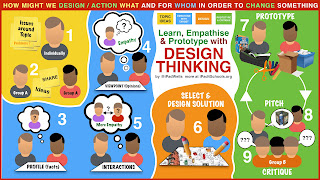Hacking into Growth – Design Thinking as a Strategy
What is Design Thinking?
It’s a practical way of
solving problems by "building up" ideas, with few, or no,
limits on breadth during a "brainstorming" phase. This helps reduce
fear of failure in the participant(s) and encourages input and participation
from a wide variety of sources in the ideation phases. The phrase "thinking
outside the box" has been coined to describe one goal of the brainstorming
phase and is encouraged, since this can aid in the discovery of hidden elements
and ambiguities in the situation and discovering potentially faulty
assumptions. When design principles are applied to strategy and innovation the
success rate for innovation dramatically improves.
Design Thinking is a
methodology used by designers to solve complex problems, and find desirable
solutions for clients.
Design Thinking draws
upon logic, imagination, intuition, and systemic reasoning, to explore
possibilities of what could be, and to create desired outcomes that benefit the
end user (the customer). A design mindset is not problem-focused, it’s solution
focused, and action oriented. It involves both analysis and imagination.
“Most people make the
mistake of thinking design is what it looks like. People think it’s this veneer
— that the designers are handed this box and told, ‘Make it look good!’ That’s
not what we think design is. It’s not just what it looks like and feels like.
Design is how it works.” — Steve Jobs
When design principles
are applied to strategy and innovation the success rate for innovation
dramatically improves.
“Design is the action of
bringing something new and desired into existence—a proactive stance that
resolves or dissolves problematic situations by design. It is a compound of
routine, adaptive and design expertise brought to bear on complex dynamic
situations.” —Harold Nelson
What are the
distinguishing characteristics of Design Thinking?
• Finding simplicity in
complexity
• Beauty as well as
functionality
• Improving quality of
experience
• Creating elegant
solutions
• Serving the needs of
people
Principles of design
thinking
Christoph Meinel and
Larry Leifer assert that there are four principles to design thinking:
• The human rule – all
design activity is ultimately social in nature
• The ambiguity rule –
design thinkers must preserve ambiguity
• The re-design rule – all
design is re-design
• The tangibility rule – making ideas tangible always facilitates communication
• The tangibility rule – making ideas tangible always facilitates communication
 |
| Kishor Jagirdar addressing the Start up owners at a CEO conclave |
Design Thinking as a
Strategy
When design principles
are applied to strategy and innovation the success rate for innovation
dramatically improves. Design thinking is at the core of effective strategy
development and organizational change. Design can be applied to products,
services, processes, physical locations… anything that needs to be optimized
for human interaction. You can design the way you lead, manage, create and
innovate.
Innovation is a
discipline that can be managed.
You can approach the
practice of innovation (creating new products, services, and customer
experiences) with a set of practical and rigorous methods, tools, and
frameworks.
Develop Design Thinking
capabilities in your organization
While learning to be a
good designer takes years, non-designers can learn to think like a designer and
apply these skills to leadership and innovation. Hands-on innovation challenges
will guide you through a design thinking process from start to finish.
- Develop the 5 discovery skills
that make up the Innovator’s DNA and optimize your ability to innovate
- Examine the four primary forces
that shape innovation and 10 types of innovation you can leverage
- How to connect more deeply with
customers to uncover opportunities for innovation
- Transform insights and data
into actionable ideas
- Explore the tool-sets and
skill-sets used by designers: empathy for your customers, idea generation,
critical thinking, aesthetic ways of knowing, problem-solving,
rapid-prototyping and collaboration
- Develop a wide variety of
concepts for products, services, experiences, messages, channels,
business models, or strategies.
- Create and implement elegant
solutions that create value for your customers, faster and more
effectively
Kishor Jagirdar has
facilitated design-thinking strategies for innovation for Product / services
organizations, software companies, industries, and government
organizations.







Comments
Post a Comment